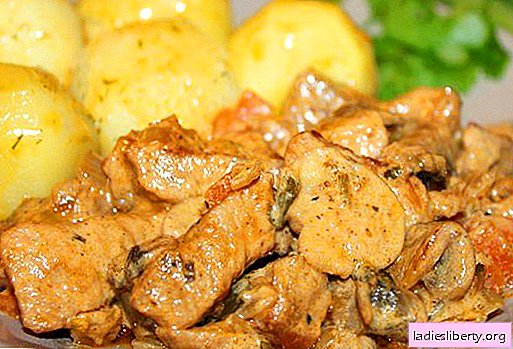
Thuja has long been popular with gardeners.
It is used to create various landscape designs, as a hedge (with the help of a hairstyle, the plant can be given any kind).
It is durable, very unpretentious (can grow on different soils, in urban environments).
In addition to the decorative function, thuja sanitizes the air, highlighting phytoncides.
Varietal and species diversity allows to grow thuya even in northern and middle latitudes.
Thuja: cultivation. Selection of planting material
It is recommended to acquire thuyu taking into account the following criteria:
1. The appearance of the plant - the twigs must be resilient, and the needles are bright, shiny, lively. If it is dull and crumbles when touched, the plant has died;
2. The earth lump must be preserved - the bare roots of the plant are unacceptable;
3. If possible, examine the root system. It should be healthy and not dried: the ends of the roots are white or yellowish in color, elastic (if they are scratched, the juice stands out);
4. It is also necessary to take into account indicators of the variety of thuja: color of needles, splendor of crown, frost resistance.
Types and varieties of thuja
Under natural conditions, there are 5 main types of thuja: Japanese, Korean, folded, eastern, western. The most popular of them is western thuja. This is a pyramidal tree, reaching a height of 15-20 m, with a crown of 3-5 m in diameter. Due to its frost resistance, it is suitable for cultivation in all regions of our country. Many varieties of this species have been developed, having various shapes, color of needles, height. The most famous are:
• Brabant - frost-resistant fast-growing variety. The diameter of the crown is 1.5 m. The color of the needles is green in summer, brown in winter.
• Emerald - is a tree, reaching a height of 4-4.5 meters. The shape of the crown is conical. Grows slowly, dark green needles in winter almost does not fade. It tolerates a haircut.
• Columna - fast-growing variety in the form of a tree with a dense narrow crown. It has a high winter hardiness, prefers semi-shady areas.
• Wagneri - variety with bluish needles, acquiring a copper hue in winter. Prefers fertile soil in open areas. It has high frost resistance.
• Globoza - Slow-growing variety with spherical crown (height of 1 m reaches 10 year of growing season), winter-hardy and drought-resistant.
• Danica - low-growing shrub with a rounded dense crown height of up to 0.6 m. It grows slowly (growth reaches only 5 cm per year). The needles have a light green color. The variety is shade tolerant, drought resistant and frost resistant. Propagated only by cuttings. Ideal for landscaping small areas.
• Golden glob - the variety has golden-green needles, grows slowly, is used in single compositions, rockeries, rock gardens and low curbs.
Thuja: cultivation. Sowing and planting (timing, shelter, temperature, soil, etc.)
For the cultivation of Tui is suitable as a sunny place, and partial shade. If you plant this coniferous plant in the shade, then its crown will thin and lose its decorative effect. Although thuja moisture-loving, but does not tolerate waterlogging. Therefore, if the groundwater is located close to the surface, then drainage should be carried out on it before planting.
Thuja can grow on different soils, but still it is better to plant it on moisture-permeable fertile lands. On heavy clay soils, it is prone to root rot. Therefore, such areas must first be enriched with humus or compost, add sand and peat to improve aeration. Acidic soils are alkalized by adding wood ash or lime.
Thuja landing
• Dig a hole 70-80 cm deep and 90-100 cm in diameter;
• Drainage from rubble, expanded clay is poured at the bottom of the pit;
• Pour prepared soil into drainage, add complex fertilizers and 2 cups of ash;
• The seedling is placed in the pit in such a way that the root neck is at the level of the ground surface;
• The distance between plants depends on the size of the variety. If thuis are planted by a group, then the interval between them ranges from 1 to 5 m, and when creating a single-row fence, it is one meter.
Growing thuja from seeds
The process of growing thuja from seeds is quite long in time: from sowing to planting seedlings to a permanent place, 3-5 years will pass. In addition, plants from seeds do not retain varietal characteristics. However, if you need at minimum cost to get a lot of strong seedlings adapted to the climatic conditions of your region, then this method fits perfectly.
Like all conifers, thuja seeds differ in their unpredictability in their germination. They can lie in the ground for more than six months before shoots appear.
Seed cones are harvested in the year of fruiting. They are laid out in a warm room in a single layer, in a couple of days they will unfold and then small reddish seeds easily spill out of them. Suitable for planting healthy seeds that have undergone natural or artificial stratification (exposure to cold).
In the first case, they are sown in the open ground after harvesting in late autumn. In spring there will be shoots similar to dill shoots. The first branches of seedlings will grow only after 6 months. To seedlings are not lost among the weeds, they can be sown in boxes, dug into the ground. In the third year, the plants dive. Young thuis can be planted at a permanent place for the fifth year of the growing season.
In the second case, the seeds are sown in a bowl with wet sand, covered with glass or film, put in a cool room or refrigerator on a shelf with a temperature of + 5ºС for 2-3 months. Periodically crops need to be aired and remove condensate. After stratification, seeds are sown in February in boxes. Substrate made from turf land, peat, sand, taken in equal proportions. For disinfection it is shed with a solution of potassium permanganate. After sowing, the soil is moistened. Seeds germinate at a temperature of + 20ºС and higher. As soon as the sprouts appear, the boxes with the seedlings are transferred to a cooler place with good lighting. Twice a month, the plants are fed with complex mineral fertilizers for conifers. Saplings dive in the second year in the spring. In the summer, pots with them are brought to the garden in partial shade. In the winter they are brought in a greenhouse or in the house. On the third spring, grown-up tui roll over into larger pots. When the plants reach 50 cm in length (4-5 year of growing season), they are transplanted to a permanent place.

Thuja seed sowing
Growing tui from cuttings
With this method of reproduction, plants retain their varietal characteristics. Some varieties of thuja can be grown only by cuttings (for example, Danica variety).
Tui cuttings are carried out in April. For cuttings choose healthy strong branches of a young plant (2-3 years). If there are no such specimens, then half-woody branches of the adult thuja are used. Cuttings should be torn off with a “heel” - a piece of bark.

Thuja cuttings with "heel"
The lower end of the cutting is 1/3 clean of the needles, soaked for a day in a root formation stimulator and planted on a garden bed in a hothouse, deepening by 2-3 cm. must first shed solution of potassium permanganate. Saplings need diffused light and high humidity (about 70%). Therefore, cuttings planted in pots, it is necessary to cover the banks. After planting, the plants must be sprayed and ventilated to prevent decay. The emergence of new shoots means that rooting was successful. In the fall (September), young plants are planted in a permanent place. For the winter, they need shelter. For this use fir spruce branches, sawdust, dry leaves.
Thuja: cultivation. Care, feeding
Care in growing thuja is watering, feeding, cutting and preparing for the winter period.
Thuja irrigation mode depends on weather conditions. Thuja is very sensitive to the soil moisture content. With a deficit of moisture, its needles grow dull and become yellow-brown in color. This is especially true after summer pruning. The minimum amount of irrigation per plant is 10 liters. In hot weather, watered every 3-4 days. It is better to do it in the morning or in the evening. Good effect on the appearance of the plant sprinkling. Daily spraying washes away dust from the needles, which begins to emit its phytoncid odor.
In the spring make compost or mineral fertilizers for coniferous plants. If fertilizing was made during planting, then the next time fertilized in 2 years.
The pristvolny circles of a thuja mulch by sawdust, compost, the crushed bark or a nutshell. Mulch retains moisture in the summer, protects the roots from overheating and freezing in the winter.
By pruning proceed to the third year of the growing season of thuja. The main pruning is carried out starting from April. At the same time, dry and diseased branches are removed, forming the selected crown shape. When trimming a hedge, shoots cut at most one third of the length.
Thuja preparing for winter. In central and northern Russia, young thujas (even frost-resistant varieties) need shelter for the first few years. The pristvolnye circles are covered with dry foliage, and the plants themselves are covered with a spanbond or thick greenhouse film. On adult plants, branches are bound with a string to the trunk in order to avoid breaking them when snow accumulates on them.

Thuja shelter for the winter
The main pests and ways to combat them
Thuja aphid - insects living in colonies and sap-eating plants. Damaged needles turn yellow and crumble. For the destruction of aphids using insecticides (for example, Fufanon).
Spider mite spreads quickly in dry warm weather. You can notice it on the branches covered with cobwebs. The needles are covered with yellow spots and showered. In case of severe injury, acaricides are used. The mite does not like increased humidity, therefore, for the prevention of tui, it is necessary to spray water more often.
Moth motley - a small butterfly, the larvae of which gnaws the moves in the needles. The shoots first turn brown and then die. For pest control, affected tui are treated twice with pyrethroids with an interval of 8 days.
Thuy pseudo shield - small light yellow insects. The affected plants wither, the needles partially dry out. In the period from May (before the dissolution of the kidneys) to mid-June, the thuja are sprayed with Carbofos, Aktellik or Aktar.
Click beetles (wireworms) - polyphagous pests. The larvae feed on small roots and humus, and as they grow they pass to thick roots. As a result, the thuja stops in development, the needles dry and crumble. Most often, the nutcrackers settle in wet areas with acidic soils. To prevent the spread of these beetles in the fall, it is necessary to dig up the soil, because adults (adult insects) winter shallowly in the ground. Low areas should be drained and alkalized. In case of mass lesions with wireworms, thuja and the surrounding vegetation are sprayed with such preparations as Fufanon, Actellik, Decis. To destroy the larvae, chemical agents with diazonin are added to the soil (Trap, Basudin).
Bark beetles - small beetles, gnawing passages and laying eggs in the bark of a tree. The affected tree quickly dies. There is no universal remedy for bark beetle. It is recommended to spray plants with insecticides at intervals of two weeks. Damaged branches are cut and burned.
Shyutte and rust - caused by various pathogenic fungi diseases in which the needles darken and fall off. Mainly young Tui are ill. The affected branches should be cut and burned to prevent the spread of mushroom spores. For prophylaxis, all conifers at the site are sprayed with the drug Hom (40 g per bucket of water), Topsin-M (15 g per bucket of water) or Bordeaux mixture. Pristvolny circles 2 times per season shed with a solution of foundationol.
Root rot - one of the most dangerous fungal diseases of the thuja. As a result of the destruction of young roots, the shoots become pale yellow, eventually turning brown, the plant dies. Sick specimens must be destroyed, and the ground under neighboring plants should be shed with a fungicide solution (for example, Fitosporin).











